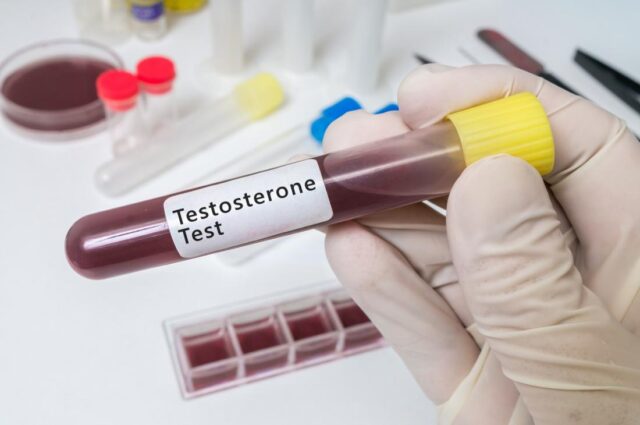
What is testosterone?
Testosterone, the male sex hormone, plays a crucial role in puberty and fertility. In men, testosterone is made in the testes, while in women, it is in the ovaries. Men tend to have higher levels of testosterone that are thought to influence the development of characteristics like body hair, bone mass, and muscle bulk.
Low testosterone in males
Testosterone levels in males usually rise around 19 years and tend to decrease after 30 years. However, some men experience abnormally low levels of testosterone. About 40% of men tend to have abnormally low levels after 45. These low levels can cause several symptoms.
Symptoms of low testosterone

The American Urology Association has identified low blood testosterone as less than 300 ng/dL. The symptoms of low testosterone levels can affect the body adversely and impact the quality of life. These symptoms include:
- decreased body hair
- low sex drive
- decreased muscle mass
- growth of breast tissue
- erectile dysfunction
If you experience one of these symptoms, then you must consult your doctor, who will test your testosterone levels.
Causes of low testosterone in males
The causes of low testosterone in males are:
- delayed puberty
- hypothalamic disease
- testicular damage (caused by trauma or alcoholism)
- noncancerous pituitary tumor
- pituitary disease
Genetic diseases like myotonic dystrophy, Kallmann syndrome, Klinefelter syndrome can also affect testosterone levels.
Testosterone test

Evaluation of low testosterone begins with a visit to a primary care physician. A testosterone test is done to measure your blood testosterone level. Thus, getting a testosterone test usually involves a blood test. In order to test your hormone levels, your doctor will give you a specific time which is usually in the morning as hormone levels are highest at that time. The test may be conducted more than once.
Your doctor may also ask you to stop certain drugs that can affect your testosterone levels. Thus, it is very important to tell your doctor about all your medications.
Your doctor may ask about your health history, like family history of diseases linked to Low-T, history of stroke, use of opiates, etc. This may be followed by a physical examination that will include prostate size and any abnormalities, hair pattern, BMI or waist circumference, etc. The following blood tests may also be done; total testosterone level, blood prolactin level, blood hemoglobin, etc.
Apart from this, testosterone home testing kits are also available. These are provided by companies like LetsGetChecked etc. and can be purchased online. They use your saliva to test the hormone levels, after which; the sample is sent to a laboratory for testing.
What do to in case of low testosterone levels?

In case of low testosterone or abnormal hormone levels, you have a wide range of treatments at your rescue. However, the exact treatment will depend upon the suspected cause of low testosterone.
Some treatments include FDA-approved oral testosterone supplements and testosterone pellet implants. Testosterone replacement therapy (TRT) is the most common treatment for low testosterone. It is given as an injection, or a topical gel, containing testosterone that replaces the missing testosterone from your body. Check out more at https://hghtherapydoctor.us/product/norditropin-flexpro-pen/
Though this is a common treatment, it is known to have some side effects: acne, blood clot formation, sleep apnea, etc.
There are five different methods of taking testosterone:

- Transdermal- These are topical creams and liquids applied to dry skin without any cuts. You can take a topical patch, which is like a band-aid with medicine on it, to avoid it from transferring to others
- Injection- Injections may be taken weekly or monthly and are of two forms, short-acting and long-acting. The short-acting ones are given under the skin, and the long-acting one is given in the muscle.
- Oral- The oral dose comes in a patch placed above the incisor. It does have to be chewed or swallowed and cause headache or irritation where it’s placed.
- Pellets- The doctor places the pellets under the skin of your upper hip after giving local anesthesia. This medication dissolves slowly and is released over 3-6 months.
- Intranasal- This medication comes in a gel and is inhaled in each nostril three times a day.
On your doctor’s recommendation, you can also stop consuming some medications that affect your testosterone levels.
Your doctor may also recommend you to bring lifestyle changes, like, exercising to build muscle and losing weight through dietary changes, based on your specific situation, that will help maintain your testosterone levels.
Some foods can help you balance your testosterone levels. So, make sure to get enough foods rich in Vitamin D and zinc and bring your testosterone levels to be normal. Garlic is also known to boost testosterone levels.
Nuts, tofu, fish, eggs, and seeds have protein. Try to get about 5-6 ounces every day, but the ideal amount will depend upon your age, sex, and other factors. Not getting enough of these foods binds your testosterone with a substance, eventually reducing its levels.
Fatty foods like tuna, salmon, and mackerel are rich in Vitamin D and are natural testosterone boosters as they play a key role in hormone production. Spinach, packed with magnesium, is another food that blocks a protein from binding with testosterone.
Conclusion
Testosterone levels in males reduce naturally with age. But, in some men, these levels go too low and produce symptoms. Treatment is available, but only after your doctor has confirmed low testosterone levels with some tests.
Talk about your concerns to your physician as an accurate diagnosis will help you find the perfect treatment. Maintain a healthy lifestyle, exercise regularly, and take a balanced diet in order to address the symptoms of low testosterone without any side effects.












